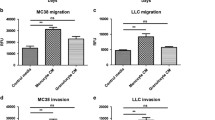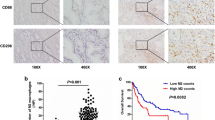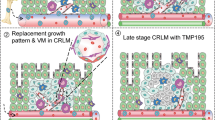Abstract
The liver is the most common site for metastasis by colorectal cancer, and numerous studies have shown a relationship between serum carcinoembryonic antigen (CEA) levels and metastasis to this site. CEA activates hepatic macrophages or Kupffer cells via binding to the CEA receptor (CEA-R), which results in the production of cytokines and the up-regulation of endothelial adhesion molecules, both of which are implicated in hepatic metastasis. Since tissue macrophages implicated in the metastatic process can often be difficult to isolate, the aim of this study was to develop an in vitro model system to study the complex mechanisms of CEA-induced macrophage activation and metastasis. Undifferentiated, human monocytic THP-1 (U-THP) cells were differentiated (D-THP) to macrophages by exposure to 200 ng/ml phorbol myristate acetate (PMA) for 18 h. Immunohistochemistry showed two CEA-R isoforms present in both U- and D-THP cells. The receptors were localized primarily to the nucleus in U-THP cells, while a significant cell-surface presence was observed following PMA-differentiation. Incubation of D-THP-1 cells with CEA resulted in a significant increase in tumor necrosis factor-alpha (TNF-α) release over 24 h compared to untreated D-THP-1 or U-THP controls confirming the functionality of these cell surface receptors. U-THP cells were unresponsive to CEA. Attachment of HT-29 cells to human umbilical vein endothelial cells significantly increased at 1 h after incubation with both recombinant TNF-α and conditioned media from CEA stimulated D-THP cells by six and eightfold, respectively. This study establishes an in vitro system utilizing a human macrophage cell line expressing functional CEA-Rs to study activation and signaling mechanisms of CEA that facilitate tumor cell attachment to activated endothelial cells. Utilization of this in vitro system may lead to a more complete understanding of the expression and function of CEA-R and facilitate the design of anti-CEA-R therapeutic modalities that may significantly diminish the metastatic potential of CEA overexpressing colorectal tumors.






Similar content being viewed by others
References
Wahl LM, Kleinman HK (1998) Tumor-associated macrophages as targets for cancer therapy. J Natl Cancer Inst 90(21):1583–1584
Banaei-Bouchareb L, Gouon-Evans V, Samara-Boustani D et al (2004) Insulin cell mass is altered in Csf1op/Csf1op macrophage-deficient mice. J Leukoc Biol 76(2):359–367
Knowles H, Leek R, Harris AL (2004) Macrophage infiltration and angiogenesis in human malignancy. Novartis Found Symp 256:189–200; Discussion 200–284, 259–269
Ohno S, Suzuki N, Ohno Y et al (2003) Tumor-associated macrophages: foe or accomplice of tumors? Anticancer Res 23(6a):4395–4409
Oosterling SJ, van der Bij GJ, Meijer GA et al (2005) Macrophages direct tumour histology and clinical outcome in a colon cancer model. J Pathol 207(2):147–155
Parker GA, Picut CA (2005) Liver immunobiology. Toxicol Pathol 33(1):52–62
Steeg PS (2006) Tumor metastasis: mechanistic insights and clinical challenges. Nat Med 12(8):895–904
Weiss L, Grundmann E, Torhorst J et al (1986) Haematogenous metastatic patterns in colonic carcinoma: an analysis of 1541 necropsies. J Pathol 150(3):195–203
Bayon LG, Izquierdo MA, Sirovich I et al (1996) Role of Kupffer cells in arresting circulating tumor cells and controlling metastatic growth in the liver. Hepatology 23(5):1224–1231
Hostetter RB, Augustus LB, Mankarious R et al (1990) Carcinoembryonic antigen as a selective enhancer of colorectal cancer metastasis. J Natl Cancer Inst 82(5):380–385
Thomas P, Gangopadhyay A, Steele G Jr et al (1995) The effect of transfection of the CEA gene on the metastatic behavior of the human colorectal cancer cell line MIP-101. Cancer Lett 92(1):59–66
Stanners CP (1998) Cell adhesion and communication mediated by the CEA family: basic and clinical perspectives, vol xvii. Harwood Academic Publishers, Amsterdam, p 306
Minami S, Furui J, Kanematsu T (2001) Role of carcinoembryonic antigen in the progression of colon cancer cells that express carbohydrate antigen. Cancer Res 61(6):2732–2735
Thomas P, Toth CA (1990) Carcinoembryonic antigen binding to Kupffer cells is via a peptide located at the junction of the N-terminal and first loop domains. Biochem Biophys Res Commun 170(1):391–396
Hammarstrom S (1999) The carcinoembryonic antigen (CEA) family: structures, suggested functions and expression in normal and malignant tissues. Semin Cancer Biol 9(2):67–81
Marx J (2004) Cancer research. Inflammation and cancer: the link grows stronger. Science 306(5698):966–968
Jessup JM, Giavazzi R, Campbell D et al (1988) Growth potential of human colorectal carcinomas in nude mice: association with the preoperative serum concentration of carcinoembryonic antigen in patients. Cancer Res 48(6):1689–1692
Toth CA, Thomas P, Broitman SA et al (1985) Receptor-mediated endocytosis of carcinoembryonic antigen by rat liver Kupffer cells. Cancer Res 45(1):392–397
Bajenova OV, Zimmer R, Stolper E et al (2001) Heterogeneous RNA-binding protein M4 is a receptor for carcinoembryonic antigen in Kupffer cells. J Biol Chem 276(33):31067–31073
Bajenova O, Stolper E, Gapon S et al (2003) Surface expression of heterogeneous nuclear RNA binding protein M4 on Kupffer cell relates to its function as a carcinoembryonic antigen receptor. Exp Cell Res 291(1):228–241
Laguinge L, Bajenova O, Bowden E et al (2005) Surface expression and CEA binding of hnRNP M4 protein in HT29 colon cancer cells. Anticancer Res 25(1A):23–31
Gangopadhyay A, Bajenova O, Kelly TM et al (1996) Carcinoembryonic antigen induces cytokine expression in Kuppfer cells: implications for hepatic metastasis from colorectal cancer. Cancer Res 56(20):4805–4810
Jessup JM, Laguinge L, Lin S et al (2004) Carcinoembryonic antigen induction of IL-10 and IL-6 inhibits hepatic ischemic/reperfusion injury to colorectal carcinoma cells. Int J Cancer 111(3):332–337
Nelson H, Ramsey PS, Donohue JH et al (1994) Cell adhesion molecule expression within the microvasculature of human colorectal malignancies. Clin Immunol Immunopathol 72(1):129–136
Brodt P, Fallavollita L, Bresalier RS et al (1997) Liver endothelial E-selectin mediates carcinoma cell adhesion and promotes liver metastasis. Int J Cancer 71(4):612–619
Laferriere J, Houle F, Taher MM et al (2001) Transendothelial migration of colon carcinoma cells requires expression of E-selectin by endothelial cells and activation of stress-activated protein kinase-2 (SAPK2/p38) in the tumor cells. J Biol Chem 276(36):33762–33772
Hostetter RB, Campbell DE, Chi KF et al (1990) Carcinoembryonic antigen enhances metastatic potential of human colorectal carcinoma. Arch Surg 125(3):300–304
Toth CA, Thomas P, Broitman SA et al (1982) A new Kupffer cell receptor mediating plasma clearance of carcinoembryonic antigen by the rat. Biochem J 204(2):377–381
Shiratsuch H, Basson MD (2005) Differential regulation of monocyte/macrophage cytokine production by pressure. Am J Surg 190(5):757–762
Foreman KE, Vaporciyan AA, Bonish BK et al (1994) C5a-induced expression of P-selectin in endothelial cells. J Clin Invest 94(3):1147–1155
Gupta B, Ghosh B (1999) Curcuma longa inhibits TNF-alpha induced expression of adhesion molecules on human umbilical vein endothelial cells. Int J Immunopharmacol 21(11):745–757
Madan B, Singh I, Kumar A et al (2002) Xanthones as inhibitors of microsomal lipid peroxidation and TNF-alpha induced ICAM-1 expression on human umbilical vein endothelial cells (HUVECs). Bioorg Med Chem 10(11):3431–3436
Sasakawa T, Sasakawa Y, Masunaga T et al (2005) FK506 suppresses E-selectin, ICAM-1 and VCAM-1 expression on vascular endothelial cells by inhibiting tumor necrosis factor alpha secretion from peripheral blood mononuclear cells. Cytokine 29(2):67–71
Hiscox S, Jiang WG (1997) Quantification of tumour cell-endothelial cell attachment by 1,1’-dioctadecyl-3,3,3’,3’-tetramethylindocarbocyanine (DiI). Cancer Lett 112(2):209–217
Jemal A, Siegel R, Ward E et al (2006) Cancer statistics, 2006. CA Cancer J Clin 56(2):106–130
Acknowledgement
Supported by the Smithwlck Funds, Department of Surgery, Boston Medical Center and NIH grant CA74941 (PT).
Author information
Authors and Affiliations
Corresponding author
Rights and permissions
About this article
Cite this article
Aarons, C.B., Bajenova, O., Andrews, C. et al. Carcinoembryonic antigen-stimulated THP-1 macrophages activate endothelial cells and increase cell–cell adhesion of colorectal cancer cells. Clin Exp Metastasis 24, 201–209 (2007). https://doi.org/10.1007/s10585-007-9069-7
Received:
Accepted:
Published:
Issue Date:
DOI: https://doi.org/10.1007/s10585-007-9069-7




